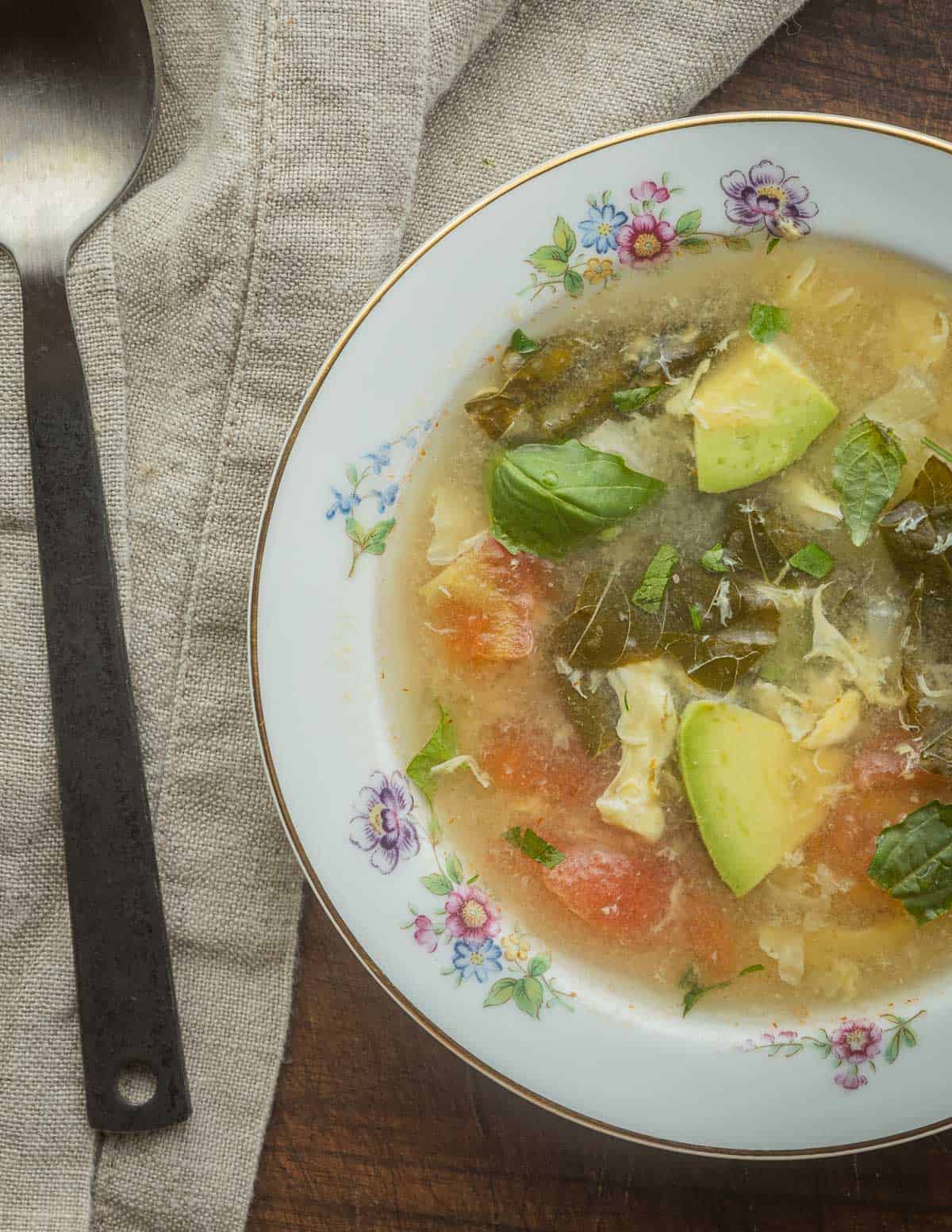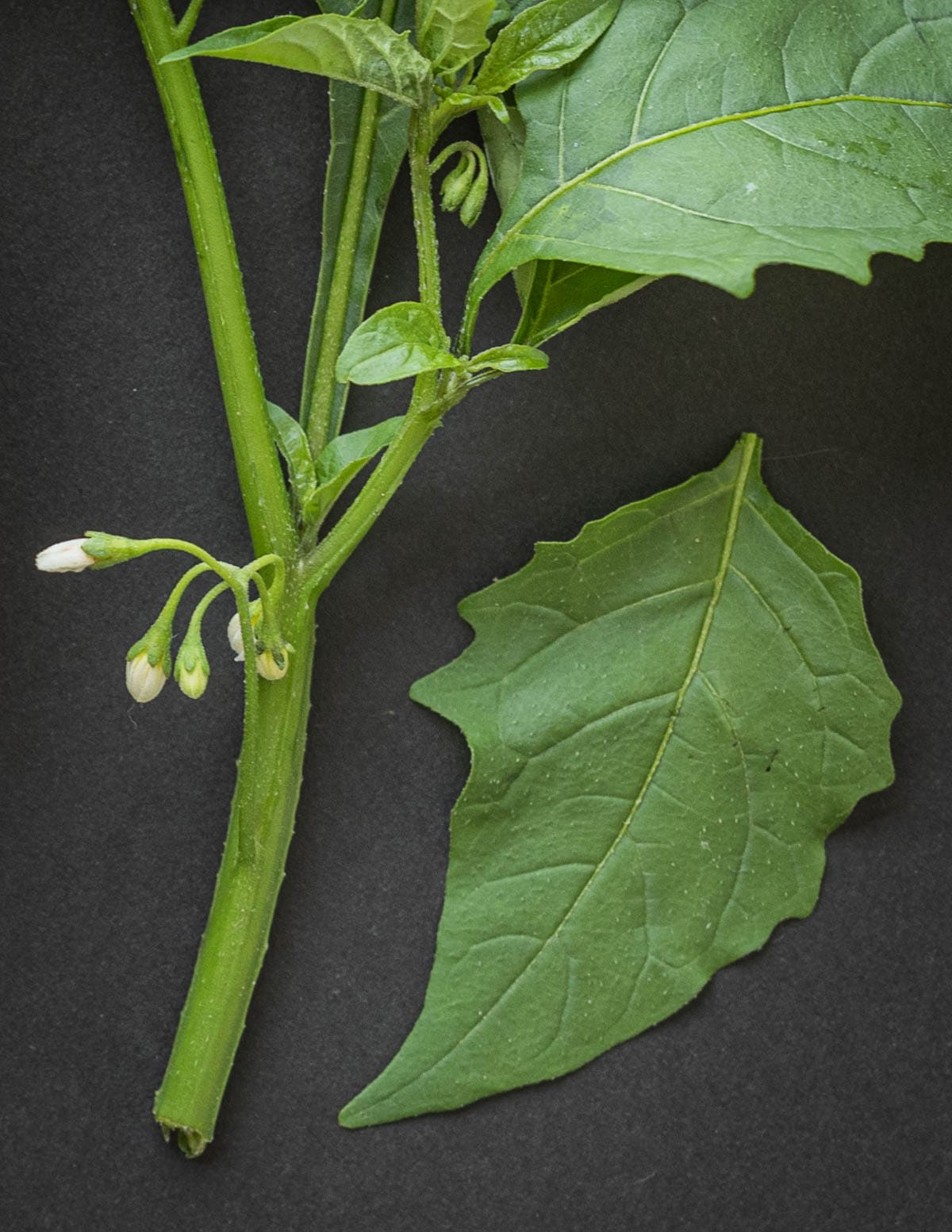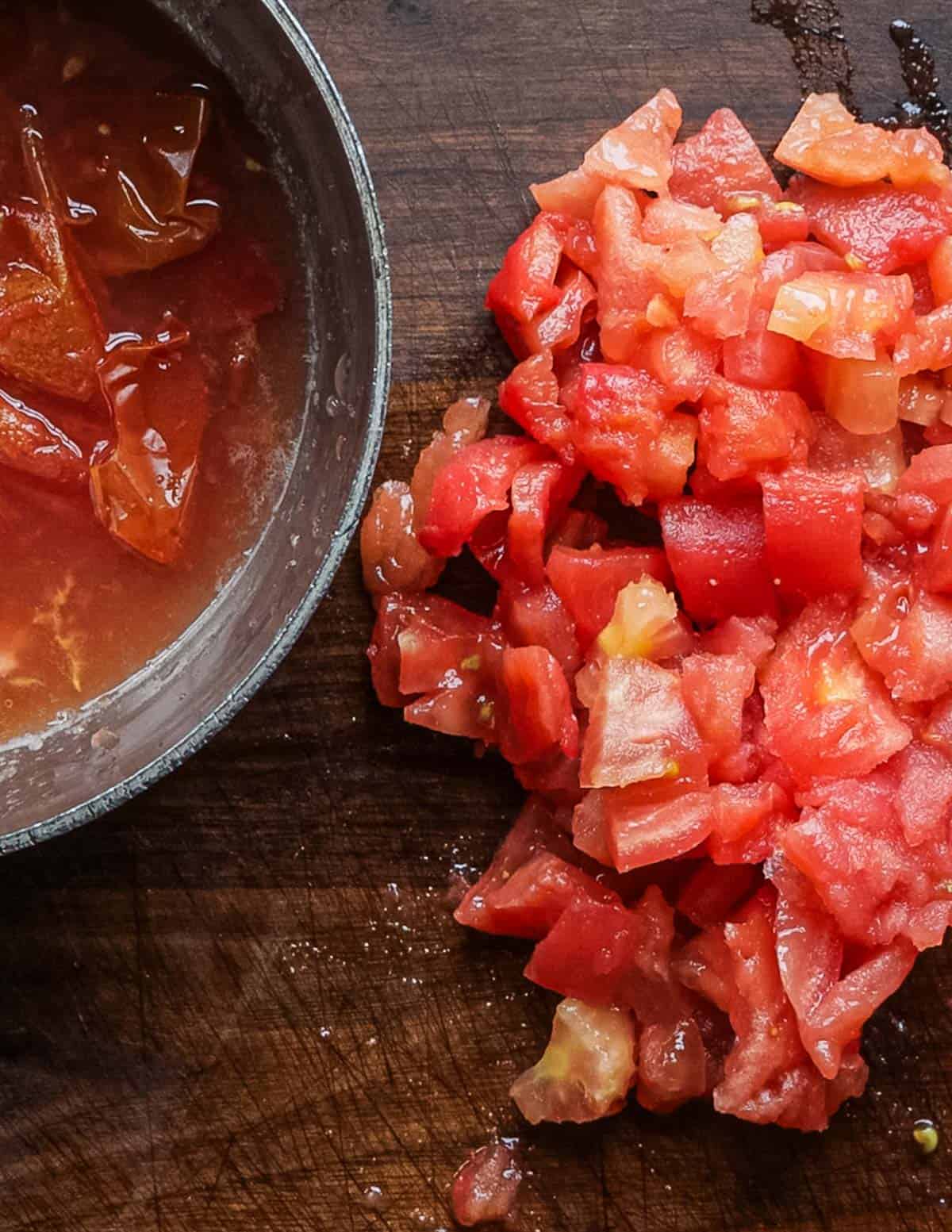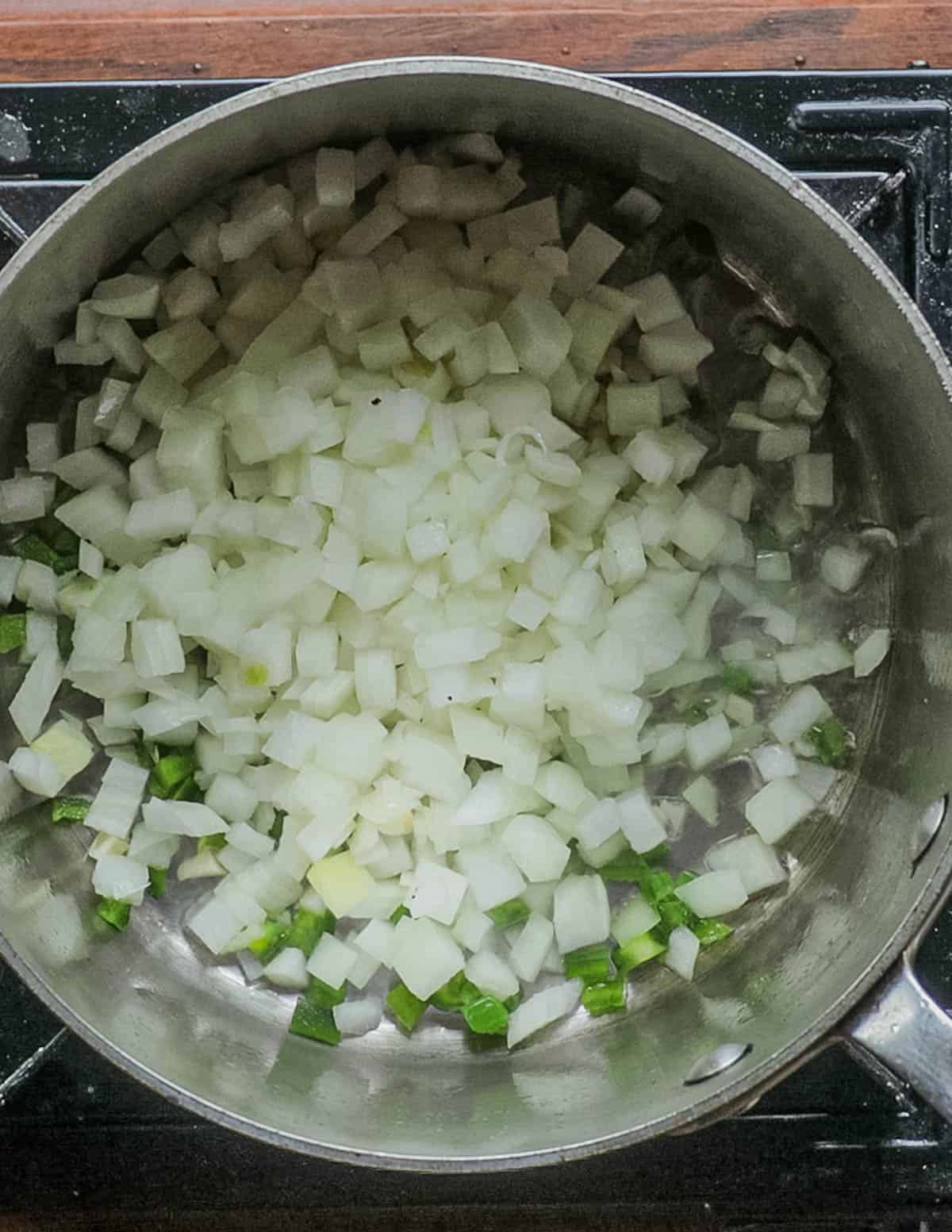A rustic dish made in El Salvador, Central America and Mexico, Sopa de Mora is a light, brothy soup of nightshade greens and vegetables finished with ribbons of beaten egg. It's delicious in its simplicity, and a good example of how learning regional common names for edible wild plants can show you new and interesting ways to cook them.

If you've read my post on black nightshade (Solanum nigrum) you'll know the Spanish name for the plant is hierba mora, and that they're one of hundreds of wild edible plants known as quelites.
Nightshade greens can be cooked like any leafy green, but having a soup dedicated to them is unique. The subtle bitter flavor of nightshade greens is almost like an herb and a vegetable.

The soup is made in Mexico and Central America, but I see the most references to Salvadorean cuisine. I've been lucky enough to have coworkers from El Salvador who answer my incessant questions about wild foods, we just talk on Whatsapp now instead of in the kitchen.
My friend Oscar recommended adding avocado, as well as mentioning the soup is good for hangovers. I can only attest to the avocado being a good move personally.
How to Make Sopa de Mora
Ideally your greens will be young and tender. But, some Latin and Asian grocers sell the greens with tough stems and unripe berries, so you may need to remove the greens from the stem if you buy them. Remove the leaves, discard any unripe green berries if present, then slice the leaves into 1 inch strips.


Diced potatoes and summer squash make up the bulk of the soup. Blanched, peeled tomatoes appear in some recipes and I like the color they add, but some versions omit them which keeps the broth nice and clear.
As it's such a simple soup, a good stock makes a big difference here, but it's not uncommon to see it made with a bouillon cube and water either.


To build the soup, sweat minced garlic, diced onion, and jalapeno in a soup pot until tender in a little oil, then add the potatoes and zucchini and cook for a few minutes. When the vegetables are nearly tender, add the chopped tomatoes. Some recipes simply add everything to the pot at once.



Next, add the chicken broth and bring the soup to a gentle simmer. Once it's hot, add the sliced nightshade greens. For a more filling soup you can add a handful of leftover cooked chicken saved from making the broth.



When the vegetables are tender the egg is added. This is the most important part, and as I learned, easy screw up if you're not paying attention. Slowly pour in the beaten egg, making sure not to stir until after the egg is completely cooked. Watch the video in this post to see how it's done.
When made correctly you should have tender ribbons of cooked egg-not a bunch of particles floating around. Beaten eaten is demonstrated in this recipe, but an individual egg for each person can also be poached directly in the soup.


After the egg is added the soup might be served with tortillas, lime wedges and a dollop of crema agria (sour cream), or simply as-is. I like some diced avocado and a few scattered herbs like basil and cilantro.
The herbs aren't traditional but they add an attractive, fresh flavor to the broth that compliments the summer vegetables. If you can find black nightshade greens you have to try it!

Variations
- Salvadorean cuisine isn't traditionally spicy but some red chili oil would make a nice garnish.
- Chicken stock is traditional, but using vegetable stock and white beans would make a nice vegetarian version.
- If you don't have nightshade greens (or if they're bug eaten like the ones in my yard) you could add a few tomato leaves mixed with lambs quarters or amaranth.
Related Posts
Sopa de Mora Salvadoreña
Equipment
- 1 3 quart sauce pot
- 1 8 oz mixing bowl
Ingredients
- 2 tablespoons Cooking oil chicken fat or lard
- 1 Jalapeno (optional) seeded and diced ¼ inch
- 1 Large clove garlic minced
- 1 Medium onion 5 oz diced ½ inch
- 1 Medium golden potato (6 oz) peeled and diced ½ inch
- 1 Zucchini or summer squash (8 oz) quartered lengthwise, seeded and diced
- 2 Small roma tomatoes, roughly 6 oz (optional)
- 8 cups Chicken stock or vegetable broth
- 4 oz Hierba mora leaves black nightshade greens, sliced into 1 inch ribbons
- 3 Large eggs beaten
- 8 oz Cooked leftover chicken from making the broth (optional)
Optional Garnishes
- 1 Avocado diced
- Fresh torn herbs like basil or cilantro
- 1 Lime, cut into wedges
- 4 Tbsp Sour cream or Mexican Crema optional
- Warmed flour or corn tortillas optional
Instructions
- Core the tomatoes and score the bottom with an X. Blanch the tomatoes in boiling water until the scored skin begins to peel back, about 30 seconds.
- Remove the tomatoes and peel, then squeeze the seeds out in a dish and discard. Roughly chop the tomatoes and reserve.
- In a 3-4 quart soup pot, sweat the garlic, jalapeno and onion in the oil for 5 minutes, or until the onion is translucent.
- Add the potatoes, zucchini, tomatoes and chicken broth, bring to a gentle simmer and cook for 15-20 minutes, or until the potatoes are tender.
- Add the sliced hierba mora leaves and cook until tender. Taste the soup and adjust the seasoning for salt, stir and repeat until it tastes good to you. Add the avocado if using.
- Pour in the egg slowly around the edge of the pot, waiting for a few seconds for the eggs to cook before stirring. Some recipes simply poach whole eggs directly in the soup.
- Don't stir the soup until the egg is completely cooked to keep the texture of the egg ribbons.
- Add the cilantro or basil if using along with the avocado, a squeeze of fresh lime and serve.


John Farrell
I’m always ready to try something new. The Nightshade Greens soup seems like something that should be in a pot here in Golden Valley. But . . .
Nightshade was ingrained in me as a youngster as a very lethal thing to feed to one’s enemies and neighbourhood bullies. Is this Nightshade something wholly different from the assassin’s tool?
Alan Bergo
Hey John, yes, if you go to the second paragraph of this post you’ll see I’ve linked to my longer and more comprehensive sive post on black nightshade. Take a few minutes to read that and everything will make sense. The assassins tool is Atropa belladonna, which you won’t find in Golden Valley. The nightshade in this soup is Solanum nigrum. It’s confusing as the common name for both plants is black nightshade. Garden huckleberry sold to gardeners for the fruit (and greens) is an edible black nightshade too (Solanum melanocerasum).
Jean B
Thank you Chef! After reading your post this spring on black nightshade this spring I let them grow around my garden to try the greens. When this email came I went outside to clip some. Made a half recipe with two eggs for my hubby and me. He couldn't believe it was the same weed he'd been pulling for years. The flavor of the greens is just lovely. Who would've thought?
Alan Bergo
Thanks Jean. I’m really excited to share more recipes for this plant. It’s so misunderstood.
LaRae
Easy and delicious!
Alan Bergo
Thanks LaRae. We should do a Central American themed dinner sometime!
Aurora
wow - thankyou xx
ive been eating black nightshade berries from childhood (and as a medicine) the greens have never occurred to me as wild green
Alan Bergo
Thanks Aurora.
Hortense
How wonderful! Thanks, Alan!
Alan Bergo
Thank you Hortense!
Gilbert
Cassandras of the kitchen will be stirred up about this, more edible nightshade. After your earlier post I bought seed and germinated it indoors. I guess it likes warm soil. So does purslane/verdolagas.
I mentioned black nightshade to a friend who went on a rant about that pestilence in his garden.
However, my new euphemistic name for it is mini-aubergine.
Alan Bergo
Hey mini-aubergine has a ring to it. Yes, I got a lot of flak in my email about my first post, but the evidence of black nightshade as a food is irrefutable. In time I think people will really grow to like this plant. The only drawback I've found is that the plants I'm growing are just perforated by bugs.
Sam S
I'm going to save this recipe, and I may make it at some point this summer. I'm wondering something. How much does The Nightshade affect the recipes flavor? Is the recipe good with almost any green? Like, could I just buy some Swiss chard and use it? Or, does the nightshade have distinct flavor that really affects the experience of this dish? You stated purslane could be a good substitute. I imagine you're correct, though the flavor purslane is quite different than Nightshade, if I remember right. I think raw, Nightshade greens are quite strong, maybe bitter. But, in a soup I can imagine they'll mellow out and could flavor the broth. A little bitter can work in some soups. I wonder what this recipe would be like using broadleaf plantain greens. Or what about clover greens?
Alan Bergo
Hey Sam. Since the soup is named for black nightshade greens I think it's important to respect the tradition here. If I substitute any other plants for the nightshade greens it would be purslane or another well known quelite, and even then it's no longer Sopa de Mora. Purslane is different from nightshade, but the succulent stems and leaves are really nice in broth.